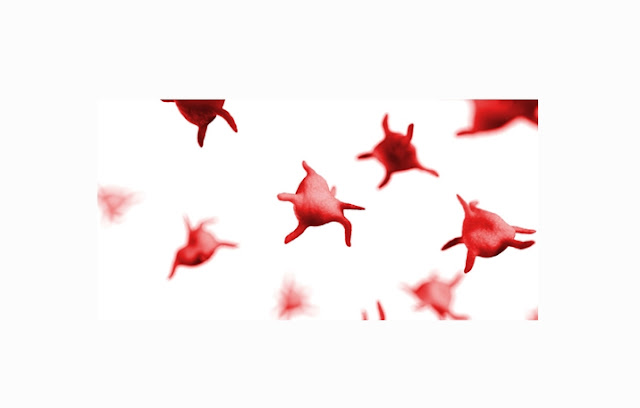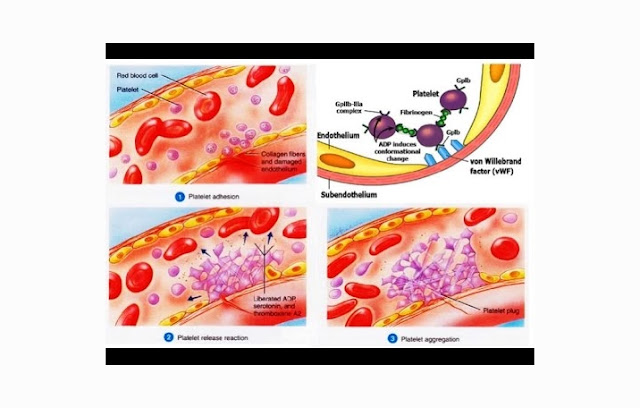A. UNDERSTANDING THE DEFINITIONS OF
PLATELETS (THROMBOCYTES)
Platelets (Thrombocytes) are one of the blood cells
whose function is to process blood clotting. Platelets are cells that have a
very important role when the occurrence of injuries or leaks in blood vessels.
Normal platelet counts in humans is 150000-400000 platelets per micro liter of
blood. The circumstances in which a person has a platelet count below 150,000
or less than normal is called thrombocytopenia, whereas if the platelet count
is higher than 400,000 so-called thrombocytosis. The life span of platelets
only last about 5-9 days in the blood. Old and broken Platelets will removed
from the bloodstream by the spleen, then replaced by new platelets.
B. THE FUNCTION OF PLATELETS
(THROMBOCYTES)
As we have mentioned previously, the main function of
platelets or platelets is for blood clotting. When blood vessels are injured or
leak, the body will perform three main mekanismr to stop the bleeding is in
progress, namely:
- Closing the injury part of the blood vessels.
- Activities of other blood coagulation components in the plasma.
Any changes that occur in the body will be detected,
as well as if there is bleeding. The first reaction is carried out by the body
is to close the injured blood vessels, the goal is to lessen the blood that
comes out with minimizing the injured holes. This reaction will trigger
platelets to stick to the injured blood vessel. Platelets will send a signal to
other platelets and various blood clotting factors in order to get to the
injured area to help close the wound. Form of platelets that are round change
to be spiny (like tentacles),so that adhesion between platelets is easier.
At the same time and place, various dissolve blood
clotting protein ; fibrinogen (because of platelet thrombin) becomes active and
turns into fibrin. Fibrin is shaped long fiber that is not soluble so that he
will stick to the platelets to form a collection of net-like structures. The
fibrin fibers are sticky so it will collect platelets, red blood cells and
white blood cells whose passing. Once the wound is closed properly then it will
be given a signal that makes the blood clotting process to stop. Without
control of the blood clotting process it will be dangerous because of a minor
injury can cause clots throughout the body.
C. HOW DOES PLATELETS (THROMBOCYTES)
WORKS
The working process of platelets to form a plug wound
consists of several stages, namely:
1. Platelet
Adhesion
Platelet adhesion is the adhesion between platelet with
endothelial tissue as well as injury tissue to close the wound from injury
blood vessels. This attachment process will make the interaction between the
surface of the platelets with the injured tissue, so it will increasing the
stickiness of platelets and calling the other coagulation factors.
2. Platelet
Aggregation
Platelet aggregation is the ability of platelets to
stick together to form a blockage. Platelets that attached to injury tissue
during the adhesion process will make more platelets attached to him so that
blockages will close the wound. However, the formation of this blockage should
not be exaggerated, because it would be dangerous and cause blockage of the
whole vessels.
3. Platelets Liberation
Liberation of platelets is a reaction to stabilize
platelets blockage (coagulation). This process is triggered by the release of
platelet granule contents, such as ADP, collagen, epinephrine, etc. This
release makes platelets change of shape into a round disc.
4. Platelets
Fusion
The fusion of platelets is combination of platelet
reaction that is irreversible. This process is triggered by the high levels of Adenosine
diphosphate (ADP) and other components that come out from the discharge reaction.
The composition of fibrin will strengthen the new tissue formed in the injured
area. The fusion of these platelets is irreversible (can not be returned).
D. LIMTATIONS OF PLATELETS (THROMBOCYTES)
FUNCTION
Continuous platelet clotting can cause blockage of
the whole blood vessels. It can be very harmful to the body. Therefore
platelets can produce material that control the Coagulation process. The main
ingredient that perform these functions are thromboxane A2, which causes the
platelets restrictions.
Tissue injury also issued prostacyclin I2 whose
function is opposite to thromboxane A2. The aim is that tissue injury still
have an active platelets. Both of these components work in a balanced manner so
that the wound is maintained by platelets and also excessive formation of clots
do not happen in the injured area.
E. THE STRUCTURE OF PLATELETS
(THROMBOCYTES)
Platelets size of about 1-4 microns, part of the cell
form like a disc, and platelets do not have a cell nucleus. Although it does
not have a nucleus, platelets can still perform the synthesis of protein
because it contains RNA in the cytoplasm. Diameter range of platelets is about
2-3 micro.
Platelets have a three-layer membrane system
(trilaminar) and has membrane system space (canaliculi). This membrane serves
as a protective platelet cells from the outside environment. The platelet
membrane rich in phospholipids which will help in the process of blood clotting.
In the sub platelet membrane there is a component called trombastin
microfilaments. This component function is as an atomyosin that play a role in
muscle contraction.
Cytoplasm of platelets contained various cell
organelles and other important structures, suc as : microtubules, nucletide,
lysosomes, granules, etc. Onthe surface of there are platelets atigens, an
important antigen which is the cause of autoimmune disease against platelets.
This antigen is called Human Platelet Antigen (HPA).
F. THE FORMATION OF PLATELETS
(THROMBOCYTES)
The process of formation and development of all blood
cells is from its precursor parent called haematopoietic. Adult blood cells
formed in the bone marrow. Meanwhile, when the fetal period, haematopoietic
occurred in the yolk, then moved to the liver and spleen, and finally to the
bone.
The formation of platelets is called megakariopoiesis
because it comes from the bone marrow to the fragmentation of the cytoplasm of
megakaryocytes. Precursor of megkaryocytes - megakarioblas, arise from the process of differentiation the
original haemopoietic cell. When the replication process began, Megakaryocytes will
increase the volume of the cytoplasm when the core number are doubled.
 |
| FORMATION OF PLATELETS (THROMBOCYTES) |
In the 8th process of replication, the cell growth will
stop. Will form granular cytoplasm and release the platelets. Each
megakaryocytes produce about 4000 pieces of platelets. These platelets are
under the control of a substance called thrombopoietin (produced by the kidneys
and liver). Newly formed platelets have more powerful hemostatic capacity and
slightly larger.




